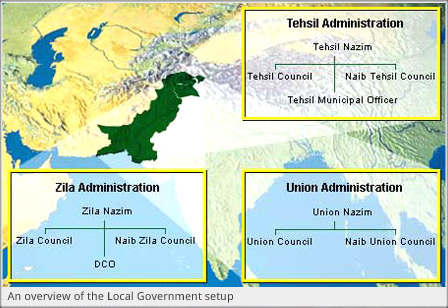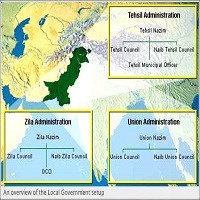In order to establish democracy at grassroots level, the regime of General Pervez Musharaf, introduced the Local Government System. This was not a new experiment in Pakistan. Ayub Khan had undertaken a similar effort in this direction by introducing the Basic Democracy System.

This new system of Local Government was installed on August 14, 2001, after holding of elections. Direct elections on non-party basis were held in five phases for members of Union Councils, Union Nazims, and Naib Union Nazims during 2000 thru to 2001. On the basis of these direct elections, indirect elections were held in July-August 2001 for Zila Nazims and Naib Zila Nazims and also for Tehsil-Town Nazims and Naib Nazims. In order to attract people towards electoral politics, the minimum age for local government elections was lowered from 21 to 18 years. One-third seats were reserved for women.
The main purpose of introducing the Local Government System was to empower the people at the grassroots level and to transfer power from the elite to the masses. This system of grassroots democracy envisaged yielding new political leaders. It was also anticipated to solve people’s problems at local level, allow public participation in decision-making and ensure the provision of speedy justice. The essence of this system was that the Local Governments would be accountable to the citizens for all their decisions. It would enable the proactive elements of society to participate in community work, development related activities and would remove rural-urban divide. The new Local Government plan was an effort on the part of the Military Government to lay the foundations of an authentic and enduring democracy.
The new System provided a three-tier Local Government structure:
- The District Government
- The Tehsil Government
- The Union Administration
The District Government
The District Government consisted of the Zila Nazim and District Administration. The District Administration consisted of district offices including sub-offices at Tehsil level, who were to be responsible to the District Nazim assisted by the District Coordination Officer. The District Coordination Officer was appointed by the Provincial Government and was the coordinating head of the District Administration. The Zila Nazim was accountable to the people through the elected members of the Zila Council. A Zila Council consisted of all Union Nazims in the District, which consisted of members elected on the reserved seats. These seats were reserved for women, peasants, workers, and minority community. The Zila Council had its Secretariat under the Naib Zila Nazim and had a separate budget allocation. Adequate checks and balances were introduced in the System.
The new System also efficiently addressed the specific needs and problems of large cities. The District Government was responsible to the people and the Provincial Government for improvement of governance and delivery of services.
Tehsil Administration
The middle tier, the Tehsil, had Tehsil Municipal Administration headed by the Tehsil Nazim. Tehsil Municipal Administration consisted of a Tehsil Nazim, Tehsil Municipal Officer, Tehsil Officers, Chief Officers and other officials of the Local Council Service and officials of the offices entrusted to the Tehsil Municipal Administration. The Tehsil Municipal Administration was entrusted with the functions of administration, finances, and management of the offices of Local Government and Rural Development, and numerous other subjects at the regional, Divisional, District, Tehsil and lower levels.
Union Administration
The lowest tier, the Union Administration was a corporate body covering the rural as well as urban areas across the whole District. It consisted of Union Nazim, Naib Union Nazim and three Union Secretaries and other auxiliary staff.
The Union Nazim was the head of the Union Administration and the Naib Union Nazim acted as deputy to the Union Nazim during his temporary absence. The Union Secretaries coordinated and facilitated in community development, functioning of the Union Committees and delivery of municipal services under the supervision of Union Nazim.
The Government allocated Rupees 32 billion to the Local Government in 2002. The funds were deposited in the account of the District Government. The District Government further distributed these funds to Tehsil and Unions. In addition to the fiscal transfers from the Province, the Local Governments were authorized to generate money from their own sources by levying certain taxes, fees, user charges, etc.
It is, however, pertinent to make a special mention that it is only in the absence of elected assemblies that local governments are the popularly elected bodies and play important political and developmental roles. After the election of Senators and members of the provincial and national assemblies, its role has been again substantially marginalized. The elected representatives of National and Provincial Assemblies usually take over some functions, which local governments used to perform and as such in many ways they are prone to intervene in the evolution of proper and improved Local government.
Local governments suffer from the fact that their existence is not constitutionally ordained and they are a mere extension of the provincial government. In the Constitution, the allocations of the functions of the federal and provincial governments are clearly specified whereas the existence of local government is not formally embodied in the Constitution. Moreover, financial, technical, and bureaucratic constraints plus limited revenue (merely 5 per cent of revenue generated by the government) cause the poor and almost non-existent local government for most of the time.
This article was last updated on Saturday, February 21, 2004






